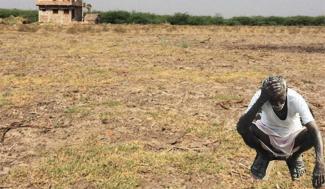
MATTER OF PRIDE
- India -- a top producer of wheat, rice, pulses, sugarcane, cotton.
- Highest producer of milk . Second highest of fruits and vegetables.
- In 2013, 25% of the world’s pulses came from India -- highest for any one country, 22% of all rice and 13% of all wheat production.
YET HOW SHAMEFUL THAT...
- In 2015, India had 40% of undernourished children of the world.
- In 2013, malnutrition rate among Indian children was two times that of children in Sub-Saharan Africa according to the World Bank.
- In 2016, Food and Agriculture Organization’s data indicated hunger in India continued to be worse than many least developed countries. Same year, the Bombay High Court expressed dismay over the death of 17,000 persons in tribal areas of Maharashtra, in just the preceding 12 months, due to malnutrition.
- The Global Nutrition Report 2017 based on data from 140 countries found India adding significantly to global burden of childhood stunting, wasting and anaemia in women of reproductive age. The report found 38% of children under five affected by stunting – children too short for their age due to lack of nutrients, suffering irreversible damage to brain capacity; 21% of children under 5 ‘wasted’ or ‘severely wasted’ – they do not weigh enough for their height and, over half of women of reproductive age suffer from anaemia.
- Surveys show farm incomes have been constantly falling. In 2011-12 according to official data, more than a fifth of rural households with agriculture as their primary occupation suffered from acute poverty and earned below poverty line incomes.
- In 2011, there were 9 million fewer farmers than in 2001. Census showed for the first time since independence, urban India added more people to its population than rural India did. Millions are leaving their villages, migrating to other villages, small towns and cities in search of jobs that are not there.
- Migration from rural areas to cities has formed numerous channels of exploitation making migrant workers a vulnerable workforce that can be subjugated and disciplined easily. The migrant job market with casual wage and contract labour system is openly abusive and brutal without any system of state regulation or redress.
In 2011–12, average wage in India was Rs 247 / day, average wage of casual workers was Rs 143 / day. Daily wages in rural areas = half of wages in urban areas, and average daily wages of casual rural female workers the lowest, Rs 104/day. In light of highly depressed wages, distress migration from rural areas will only add to further depressing the wages.
The agrarian crisis needs to be addressed for those whose livelihood depends on farming. Such upheaval as being currently witnessed in rural India cannot leave its cities untouched. As distress migration from rural India continues unabated, and intensifies, the pressure would be as much on urban India.
The very model of our social, economic, and perhaps political organisation, is under threat.
It would be myopic for anyone to feel insulated from the rural tragedy that is unfolding right now.
Liberation Archive
- 2001-2010
-
2011-2020
- 2011
- 2012
- 2013
- 2014
- 2015
- 2016
- 2017
- 2018
-
2019
-
JANUARY-2019
- Oust the Fascist Modi Regime! Rescue India, Rebuild India!
- Assembly Elections 2018: A Blow To Fascist Politics
- The Elitist Reaction to the Zomato Delivery Man
- More Orders, More Money
- Why I Stole food
- Kisan Mukti March : When United Peasant Resistance Defused The Fascist Aggression
- Kisan Mukti March : The Farmers' Freedom March
- Kisan Mukti March : Civil Society and Opposition Parties Come out in Support
- MANIFESTO OF INDIAN FARMERS
- Farmers' Unity will become the Biggest Force in Fighting Fascism
- Save Our Farmers
- The Fraud of Farm Suicide Numbers
- Agrarian Crisis = Nation's Crisis
- Sinking in a Sea of Debt
- Why The Market Has Not Worked For Farmers
- Agrarian Crisis: A Crisis of Women Farmers
- Overworked, Underpaid, Unrecognised: Bihar ASHAs on Indefinite Strike
- Seminar: 'Women's Rights and Increasing Attacks on Democracy'
- Supreme Court as Custodian of the Constitution
- Comrade Vinod Mishra's Bhojpur
- Why Supreme Court Order Doesn't Amount to 'Clean Chit' to Modi Government on Rafale
- All Over The World, Home Is The Most Unsafe For Women
- FEBRUARY-2019
- MARCH-2019
- APRIL-2019
- May-2019
- LIBERATION, JUNE 2019
- Liberation JULY 2019
- LIBERATION, August 2019
- Liberation, SEPTEMBER 2019
- Liberation, OCTOBER 2019
- Liberation, NOVEMBER 2019
- Liberation, DECEMBER 2019
-
JANUARY-2019
- 2020
- 2021-2030
Charu Bhawan, U-90, Shakarpur, Delhi 110092
Phone: +91-11-42785864 | Fax:+91-11-42785864 | +91 9717274961
E-mail: info@cpiml.org







